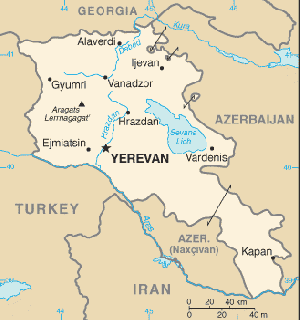Armenia
Armenia is a land known in the Bible as Ararat (Isaiah 37:38; 2 Kings 19:37) and bounded roughly by the Taurus Mountains on the west and Caucasus Mountains on the north. The principal portion lies within Turkish territory in Asia Minor; a second portion lies in Trans-Caucasia, later incorporated as an Armenian Republic in the Soviet Union; a third portion lies in the northwest tip of Persia. It is a land of plateaus, mountain peaks and important river sources. Early inhabitants were replaced about the 6th century B.C. by an invasion of Aryans who became ancestors of the present Armenians. Repeated invasions culminating in the 11th to the 14th centuries destroyed the last vestige of political independence.
Conversion to Christianity occurred under Gregory the Illuminator, an Armenian prince, who won the king in 261. The Armenian church is thus known as the Gregorian Church. With the loss of political existence Armenian nationalism has centered about the Patriarch as head of the church. Both Roman Catholics and Protestants have sought to do missionary work among the Armenians, the former hoping to win the old church to alignment with Rome and the latter to a reformed, revived position. Both were unsuccessful in their primary aim but succeeded in organizing separate Christian groups. Following the terrible massacres of 1894-1896 when 88,000 Armenians lost their lives at the hands of the Turks, efforts were made to relieve distress. Among other agencies one Mennonite mission came into being at that time—the United Orphanage and Mission at Hadjin, Turkey. Although the society was organized on an interdenominational basis the Mennonite Brethren in Christ were at all times predominant on its board. About 20 workers from this church served in the mission between 1898 and 1938. Rose Lambert and Anna Gerber were the first to go. The former was the author of Hadjin and the Armenian Massacres (Fleming Revell, 1911). Work was carried on in Hadjin and at Everek, but after World War I it was transferred from Armenia to Syria—Alexandretta, Damascus, Kirik Khan, Latakie, Beirut, and Aleppo. By 1938 it was necessary to withdraw the remaining missionaries, but the church continued on an indigenous basis.
Bibliography
Hege, Christian and Christian Neff. Mennonitisches Lexikon, 4 vols. Frankfurt & Weierhof: Hege; Karlsruhe: Schneider, 1913-1967: v. I, 83.
Report of the United Orphanage and Mission of Hadjin and Everek, Turkey, in Asia. Dayton, OH, 1911.
Storms, Everek R. What God Hath Wrought. Springfield, Ohio, 1948.
| Author(s) | Samuel Floyd Pannabecker |
|---|---|
| Date Published | 1953 |
Cite This Article
MLA style
Pannabecker, Samuel Floyd. "Armenia." Global Anabaptist Mennonite Encyclopedia Online. 1953. Web. 16 Apr 2024. https://gameo.org/index.php?title=Armenia&oldid=143861.
APA style
Pannabecker, Samuel Floyd. (1953). Armenia. Global Anabaptist Mennonite Encyclopedia Online. Retrieved 16 April 2024, from https://gameo.org/index.php?title=Armenia&oldid=143861.
Adapted by permission of Herald Press, Harrisonburg, Virginia, from Mennonite Encyclopedia, Vol. 1, pp. 158-159. All rights reserved.
©1996-2024 by the Global Anabaptist Mennonite Encyclopedia Online. All rights reserved.

